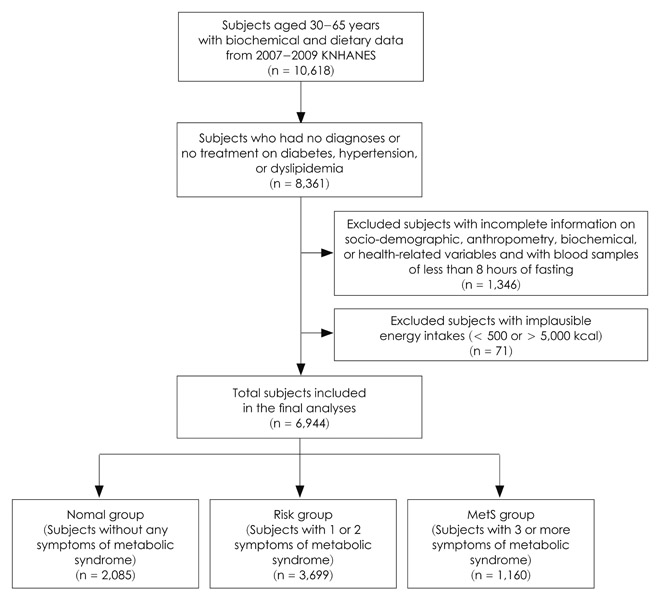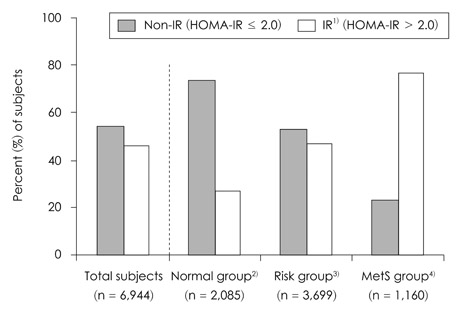Korean J Nutr.
2013 Feb;46(1):61-71. 10.4163/kjn.2013.46.1.61.
The relationship between intake of nutrients and food groups and insulin resistance in Korean adults: Using the Fourth Korea National Health and Nutrition Examination Survey (KNHANES IV, 2007-2009)
- Affiliations
-
- 1Department of Food and Nutrition, Seoul National University, Seoul 151-742, Korea.
- 2Major of Food and Nutrition, School of Human Ecology, The Catholic University of Korea, Bucheon 420-743, Korea. yjsong@catholic.ac.kr
- KMID: 2269188
- DOI: http://doi.org/10.4163/kjn.2013.46.1.61
Abstract
- The aim of this study was to examine the relationship between dietary variables and the prevalence of insulin resistance (IR) in middle-aged Korean adults using data from the 2007-2009 Korea National Health and Nutrition Examination Survey. Because IR is closely linked with metabolic syndrome, subjects were divided into three groups according to symptoms of metabolic syndrome: the 'Normal group' without any symptoms, the 'Risk group' with one or two symptoms, and the 'Metabolic syndrome (MetS) group' with three or more symptoms. Subjects between the ages of 30 and 65 years with no prior diagnosis or treatment for diabetes, hypertension, or dyslipidemia were selected. The number of subjects per group was as follows: 2,085 adults in the Normal group, 3,699 adults in the Risk group, and 1,160 adults in the MetS group. Metabolic syndrome was defined according to Adult Treatment Panel III criteria with modified waist circumference cutoff values (men > or = 90 cm, women > or = 85 cm). Subjects with HOMA-IR > 2.0 were classified as IR. Homeostasis Model Assessment of Insulin Resistance (HOMA-IR) was calculated using the following formula: (fasting plasma glucose x fasting plasma insulin)/22.5. Nutrients and food groups intake were obtained from a single 24-hour recall. Subjects with IR in the Normal group were more obese and less physically active than non-IR subjects. In the MetS group, subjects with IR were more obese and had a lower prevalence of smoking and drinking, compared with non-IR subjects. Men with IR in the Normal group had a tendency to consume more oils and sugars than non-IR men, while women with IR in the same group had higher intake of carbohydrate, dietary glycemic index, and dietary glycemic load than non-IR women. Women with IR in the Risk group had lower energy intake but higher intake of oils and sugars than non-IR women. In the MetS group, consumption of fruits was higher in subjects with IR than in non-IR subjects. In conclusion, findings of this study suggest that dietary carbohydrate intake, including glycemic index, may be associated with IR in healthy women. Further research in prospective cohort studies in order to examine the effects of dietary carbohydrate on IR incidence will be necessary.
MeSH Terms
-
Adult
Carbohydrates
Cohort Studies
Dietary Carbohydrates
Drinking
Dyslipidemias
Energy Intake
Fasting
Female
Fruit
Glucose
Glycemic Index
Homeostasis
Humans
Hypertension
Incidence
Insulin
Insulin Resistance
Korea
Male
Nutrition Surveys
Oils
Plasma
Prevalence
Smoke
Smoking
Waist Circumference
Carbohydrates
Dietary Carbohydrates
Glucose
Insulin
Oils
Smoke
Figure
Cited by 2 articles
-
Development of a Food Exchange Table and Food Pattern for Nutritionally Balanced Menu Planning
Yun Ahn, Ikhyun Yeo, Sangyun Lee, Kisun Nam
Korean J Community Nutr. 2018;23(5):411-423. doi: 10.5720/kjcn.2018.23.5.411.Study of the mechanisms underlying increased glucose absorption in
Smilax china L. leaf extract-treated HepG2 cells∗
Yun Hwan Kang, Dae Jung Kim, Kyoung Kon Kim, Sung Mee Lee, Myeon Choe
J Nutr Health. 2014;47(3):167-175. doi: 10.4163/jnh.2014.47.1.167.
Reference
-
1. Lim S, Shin H, Song JH, Kwak SH, Kang SM, Yoon JW, Choi SH, Cho SI, Park KS, Lee HK, Jang HC, Koh KK. Increasing prevalence of metabolic syndrome in Korea: the Korean National Health and Nutrition Examination Survey for 1998-2007. Diabetes Care. 2011; 34(6):1323–1328.2. Grundy SM. Metabolic syndrome pandemic. Arterioscler Thromb Vasc Biol. 2008; 28(4):629–636.
Article3. Alberti KG, Zimmet P, Shaw J. Metabolic syndrome-a new world-wide definition. A Consensus Statement from the International Diabetes Federation. Diabet Med. 2006; 23(5):469–480.
Article4. Reaven GM. Banting lecture 1988. Role of insulin resistance in human disease. Diabetes. 1988; 37(12):1595–1607.
Article5. Grundy SM. Hypertriglyceridemia, insulin resistance, and the metabolic syndrome. Am J Cardiol. 1999; 83(9B):25F–29F.
Article6. Mikhail N. The metabolic syndrome: insulin resistance. Curr Hypertens Rep. 2009; 11(2):156–158.
Article7. Bonora E, Targher G, Alberiche M, Bonadonna RC, Saggiani F, Zenere MB, Monauni T, Muggeo M. Homeostasis model assessment closely mirrors the glucose clamp technique in the assessment of insulin sensitivity: studies in subjects with various degrees of glucose tolerance and insulin sensitivity. Diabetes Care. 2000; 23(1):57–63.
Article8. McKeown NM, Meigs JB, Liu S, Saltzman E, Wilson PW, Jacques PF. Carbohydrate nutrition, insulin resistance, and the prevalence of the metabolic syndrome in the Framingham Offspring Cohort. Diabetes Care. 2004; 27(2):538–546.
Article9. Lee S, Kang ES, Lee KE, Jin H, Choi SH, Kim DJ, Ahn CW, Cha BS, Lim SK, Lee HC, Huh KB. Insulin resistance can predict the risk of metabolic syndrome. Korean J Med. 2002; 63(1):54–60.10. Lau C, Faerch K, Glümer C, Tetens I, Pedersen O, Carstensen B, Jørgensen T, Borch-Johnsen K. Inter99 study. Dietary glycemic index, glycemic load, fiber, simple sugars, and insulin resistance: the Inter99 study. Diabetes Care. 2005; 28(6):1397–1403.
Article11. O'Sullivan TA, Bremner AP, O'Neill S, Lyons-Wall P. Glycaemic load is associated with insulin resistance in older Australian women. Eur J Clin Nutr. 2010; 64(1):80–87.12. Simmons RK, Alberti KG, Gale EA, Colagiuri S, Tuomilehto J, Qiao Q, Ramachandran A, Tajima N, Brajkovich Mirchov I, Ben-Nakhi A, Reaven G, Hama Sambo B, Mendis S, Roglic G. The metabolic syndrome: useful concept or clinical tool? Report of a WHO Expert Consultation. Diabetologia. 2010; 53(4):600–605.
Article13. Song S, Choi H, Lee S, Park JM, Kim BR, Paik HY, Song Y. Establishing a table of glycemic index values for common Korean foods and an evaluation of the dietary glycemic index among the Korean adult population. Korean J Nutr. 2012; 45(1):80–93.
Article14. Du H, van der A DL, van Bakel MM, van der Kallen CJ, Blaak EE, van Greevenbroek MM, Jansen EH, Nijpels G, Stehouwer CD, Dekker JM, Feskens EJ. Glycemic index and glycemic load in relation to food and nutrient intake and metabolic risk factors in a Dutch population. Am J Clin Nutr. 2008; 87(3):655–661.
Article15. Murakami K, Sasaki S, Takahashi Y, Okubo H, Hirota N, Notsu A, Fukui M, Date C. Reproducibility and relative validity of dietary glycaemic index and load assessed with a self-administered diet-history questionnaire in Japanese adults. Br J Nutr. 2008; 99(3):639–648.
Article16. The Korean Nutrition Society. Dietary reference intakes for Koreans. 2010. 1st revision. Seoul: The Korean Nutrition Society.17. The Rural Development Administration. Food nutrient data by portions commonly used. 2009. 1st revision. Suwon: The Rural Development Administration.18. The Korean Dietetic Association. Samsung Medical Center. Food photo of the eye-to-weight. 1999. Seoul: The Korean Dietetic Association.19. Matthews DR, Hosker JP, Rudenski AS, Naylor BA, Treacher DF, Turner RC. Homeostasis model assessment: insulin resistance and beta-cell function from fasting plasma glucose and insulin concentrations in man. Diabetologia. 1985; 28(7):412–419.
Article20. Schwimmer JB, Deutsch R, Rauch JB, Behling C, Newbury R, Lavine JE. Obesity, insulin resistance, and other clinicopathological correlates of pediatric nonalcoholic fatty liver disease. J Pediatr. 2003; 143(4):500–505.
Article21. Eslam M, Aparcero R, Kawaguchi T, Del Campo JA, Sata M, Khattab MA, Romero-Gomez M. Meta-analysis: insulin resistance and sustained virological response in hepatitis C. Aliment Pharmacol Ther. 2011; 34(3):297–305.
Article22. Grundy SM, Cleeman JI, Daniels SR, Donato KA, Eckel RH, Franklin BA, Gordon DJ, Krauss RM, Savage PJ, Smith SC Jr, Spertus JA, Costa F. American Heart Association. National Heart, Lung, and Blood Institute. Diagnosis and management of the metabolic syndrome: an American Heart Association/National Heart, Lung, and Blood Institute Scientific Statement. Circulation. 2005; 112(17):2735–2752.23. Lee SY, Park HS, Kim DJ, Han JH, Kim SM, Cho GJ, Kim DY, Kwon HS, Kim SR, Lee CB, Oh SJ, Park CY, Yoo HJ. Appropriate waist circumference cutoff points for central obesity in Korean adults. Diabetes Res Clin Pract. 2007; 75(1):72–80.
Article24. McAuley KA, Williams SM, Mann JI, Goulding A, Chisholm A, Wilson N, Story G, McLay RT, Harper MJ, Jones IE. Intensive lifestyle changes are necessary to improve insulin sensitivity: a randomized controlled trial. Diabetes Care. 2002; 25(3):445–452.
Article25. Meigs JB, D'Agostino RB Sr, Wilson PW, Cupples LA, Nathan DM, Singer DE. Risk variable clustering in the insulin resistance syndrome. The Framingham Offspring Study. Diabetes. 1997; 46(10):1594–1600.
Article26. Miyatake N, Nishikawa H, Morishita A, Kunitomi M, Wada J, Suzuki H, Takahashi K, Makino H, Kira S, Fujii M. Daily walking reduces visceral adipose tissue areas and improves insulin resistance in Japanese obese subjects. Diabetes Res Clin Pract. 2002; 58(2):101–107.
Article27. Park HS, Oh SW, Cho SI, Choi WH, Kim YS. The metabolic syndrome and associated lifestyle factors among South Korean adults. Int J Epidemiol. 2004; 33(2):328–336.
Article28. Reaven GM. Diet and syndrome X. Curr Atheroscler Rep. 2000; 2(6):503–507.
Article29. Murakami K, Sasaki S, Takahashi Y, Okubo H, Hosoi Y, Horiguchi H, Oguma E, Kayama F. Dietary glycemic index and load in relation to metabolic risk factors in Japanese female farmers with traditional dietary habits. Am J Clin Nutr. 2006; 83(5):1161–1169.
Article30. Kim K, Yun SH, Choi BY, Kim MK. Cross-sectional relationship between dietary carbohydrate, glycaemic index, glycaemic load and risk of the metabolic syndrome in a Korean population. Br J Nutr. 2008; 100(3):576–584.
Article31. Levitan EB, Cook NR, Stampfer MJ, Ridker PM, Rexrode KM, Buring JE, Manson JE, Liu S. Dietary glycemic index, dietary glycemic load, blood lipids, and C-reactive protein. Metabolism. 2008; 57(3):437–443.
Article32. Finley CE, Barlow CE, Halton TL, Haskell WL. Glycemic index, glycemic load, and prevalence of the metabolic syndrome in the Cooper Center Longitudinal Study. J Am Diet Assoc. 2010; 110(12):1820–1829.
Article33. Choi H, Song S, Kim J, Chung J, Yoon J, Paik HY, Song Y. High carbohydrate intake was inversely associated with high-density lipoprotein cholesterol among Korean adults. Nutr Res. 2012; 32(2):100–106.
Article34. Park SH, Lee KS, Park HY. Dietary carbohydrate intake is associated with cardiovascular disease risk in Korean: analysis of the third Korea National Health and Nutrition Examination Survey (KNHANES III). Int J Cardiol. 2010; 139(3):234–240.
Article35. Yoo S, Nicklas T, Baranowski T, Zakeri IF, Yang SJ, Srinivasan SR, Berenson GS. Comparison of dietary intakes associated with metabolic syndrome risk factors in young adults: the Bogalusa Heart Study. Am J Clin Nutr. 2004; 80(4):841–848.
Article36. Lutsey PL, Steffen LM, Stevens J. Dietary intake and the development of the metabolic syndrome: the Atherosclerosis Risk in Communities study. Circulation. 2008; 117(6):754–761.
Article37. Shin A, Lim SY, Sung J, Shin HR, Kim J. Dietary intake, eating habits, and metabolic syndrome in Korean men. J Am Diet Assoc. 2009; 109(4):633–640.
Article38. Jung HJ, Han SN, Song S, Paik HY, Baik HW, Joung H. Association between adherence to the Korean Food Guidance System and the risk of metabolic abnormalities in Koreans. Nutr Res Pract. 2011; 5(6):560–568.
Article39. Cheung BM. The cardiovascular continuum in Asia-a new paradigm for the metabolic syndrome. J Cardiovasc Pharmacol. 2005; 46(2):125–129.
Article
- Full Text Links
- Actions
-
Cited
- CITED
-
- Close
- Share
- Similar articles
-
- Association of Household Food Security with Dietary Intake: Based on the Third (2005) Korea National Health and Nutrition Examination Survey (KNHANES III)
- Food and Nutrient Intakes According to Income in Korean Men and Women
- Dietary Cholesterol Intake in the Korea National Health and Nutrition Examination Survey (KNHANES) VI (2013–2015)
- Reanalysis of 2007 Korean National Health and Nutrition Examination Survey (2007 KNHANES) Results by CAN-Pro 3.0 Nutrient Database
- Study of the Coverage of Nutrition Labeling System on the Nutrient Intake of Koreans - using the 2013 Korea National Health and Nutrition Examination Survey (KNHANES) Data



